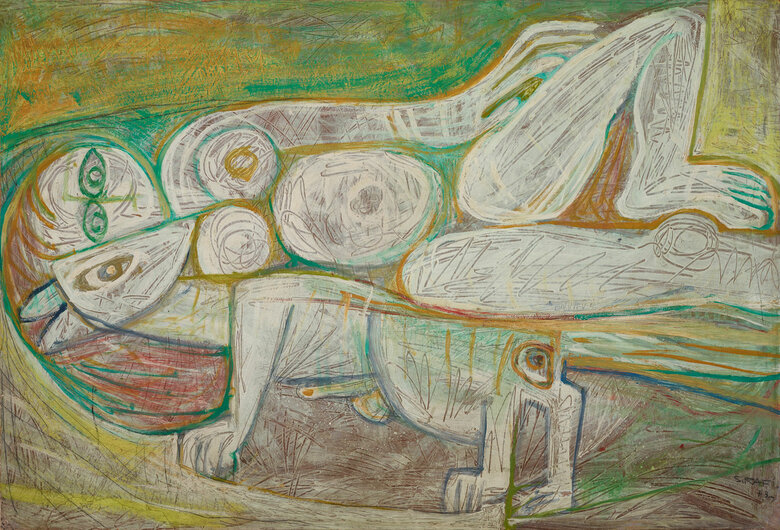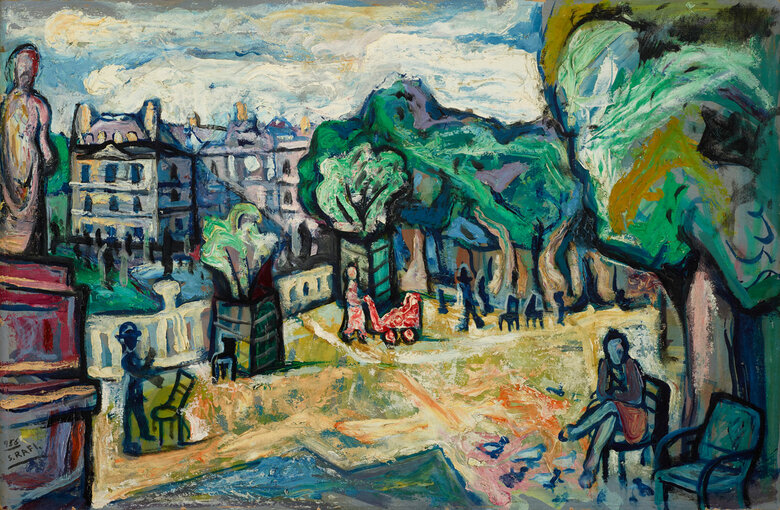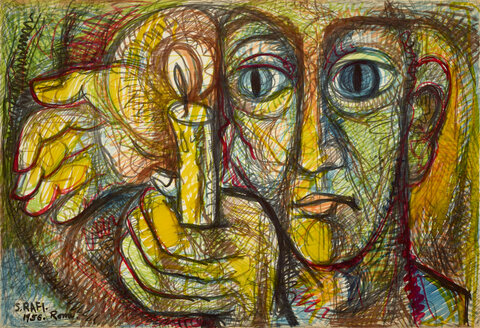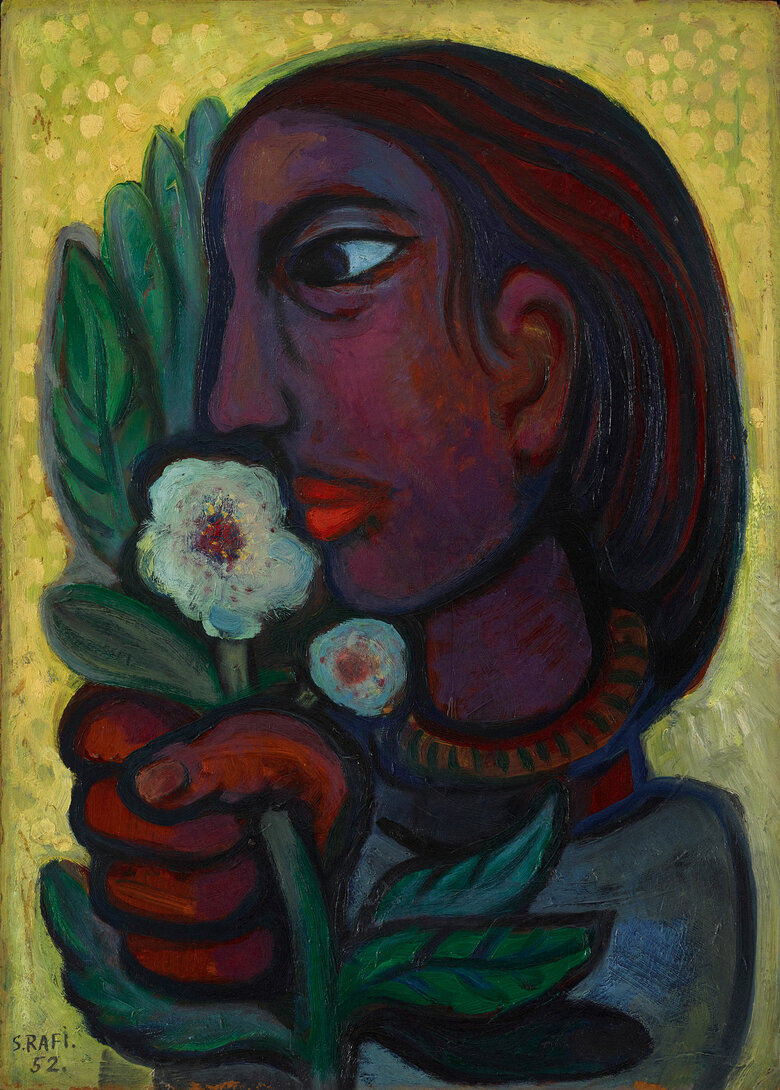Momie Ressuscitée, 1959 is a 214cmx68cm oil painting on burlap by Egyptian artist Samir Rafi depicting a female mummy in a cubist, minimalist style. Rafi mainly utilizes three colors, red, blue, and green in differing shades against the natural brown of the burlap, which maintains an earthy tone to the painting. His choice of material also allows for the rough textureof the canvas material to come through, thus retaining the effect of the gauze wrapped around the mummified body. The ‘resuscitated mummy’ is brought to life through her open eyes and visible anatomy, which is highlighted via Rafi’s use of two geometric shapes that would become attributable to his distinct style, the straight line and the circle, both accentuated by his dark contouring. The connected lines across the entire form give the impression that this piece is fully contained and held together – it is whole, much like a mummified body.
Here, Rafi bares the mummy and gives her a solid presence. The woman stares into the viewers face, and in turn, the viewers eyes are drawn to the main colorful features of this painting, her hair and her eye. Rafi’s choice of a resuscitated female mummy is also intriguing, since female mummies were often found to be more decomposed than their male counterparts 1; however, more importantly, this painting can be seen as a representation of Rafi’s perspective on the female form and her being.
The painting showcases the neo-pharaonic character that Rafi’s work had become known for, especially during his time in Paris while he was pursuing his academic studies, where he focused on ancient Egyptian art at the Ecole du Louvre 2. This period saw the evolution of his style, especially his tendency to blend cubist aspects, particularly in the style of Georges Braque 3 and his use of various media, with pharaonic inspired themes that draw upon ancient Egyptian art. However, his choice of the mummy is not necessarily solely an aesthetic decision that is meant to cater to a more authentic Egyptian character; rather, it is better understood as part of Rafi’s lifelong pursuit of capturing an Egyptian essence that moves away from elitist nationalistic overtures.
The surrealist motifs had been part of Rafi’s repertoire since his early years as a student and artist in Cairo. His work would be included in the 1944 Independent art exhibit by the Art and Liberty group 4 . By 1945, Rafi’s visual language had its own distinct characteristics with his focus on Egyptianizing surrealism. Rafi was one of the co-founders of one of the most creatively prolific art movements of Egypt, the Contemporary Art Group, whose objective was to locate and reflect the Egyptian soul 5. The group’s manifesto makes clear that their purpose is to move away from the ‘rigidity’ and constraints of the ‘ivory tower’ 6. They viewed the role of the artist as one of a leader or guide to unravelling the ‘unconscious perceptions’, and art as a ‘tool of attack and knowledge’ 7. Rafi saw in art the potential for resistance, and his works throughout his lifetime continued to reflect his belief in the language of Egyptian surrealism.
Notes:
1 Herodotus. 2008. The History Of Herodotus, Volume 1 (of 2). Translated by G. C. Macaulay. Project Gutenberg.
Accessed September 18, 2023. https://www.gutenberg.org. Females were kept at home three or four days before being sent to the embalmers in order to make them less ‘appealing’ “The wives of men of rank when they die are not given at once to be embalmed, nor such women as are very beautiful or of greater regard than others, but on the third or fourth day after their death (and not before) they are delivered to the embalmers. They do so about this matter in order that the embalmers may not abuse their women, for they say that one of them was taken once doing so to the corpse of a woman lately dead, and his fellow-craftsman gave information.” (Book II:89)
2 Kanafani, Fatenn Mostafa. 2019. Uncensored - Samir Rafi. Exhibition catalogue. ARTTalks, Egypt. Published on February 24, 2019. Rafi studied ancient Egyptian at from 1955-1958 at the Ecole du Louvre.
3 The Art Story. 'Georges Braque Artist Overview and Analysis.' Accessed October 2, 2023. https://www.theartstory.org. George Braque was a major 20 th century French painter known for his contributions to developing cubism as a revolutionary art form. His works are known for their balance and harmony is relation to color, line, and texture.
4 The Art and Liberty Group was founded in 1939 and is connected to European anti-fascism and freedom of expression. Within the nationalistic milieu of Egypt in the mid-20 th century, the group was seen as elitist and too western oriented. It was dismantled in 1946 under the rule of President Gamal Abdel Nasser.
5 Mikdadi, Salwa. "Egyptian Modern Art." In Heilbrunn Timeline of Art History. New York: The Metropolitan Museum of Art, 2000–.October 2004. http://www.metmuseum.org.
6 Lenssen, Anneka, Sarah A. Rogers, and Nada M. Shabout, eds. Modern Art in the Arab World: Primary Documents. New York: Museum of Modern Art, 2018.
7 Modern Art in the Arab World, 2018.



-Front.jpg)
-Front.jpg)









